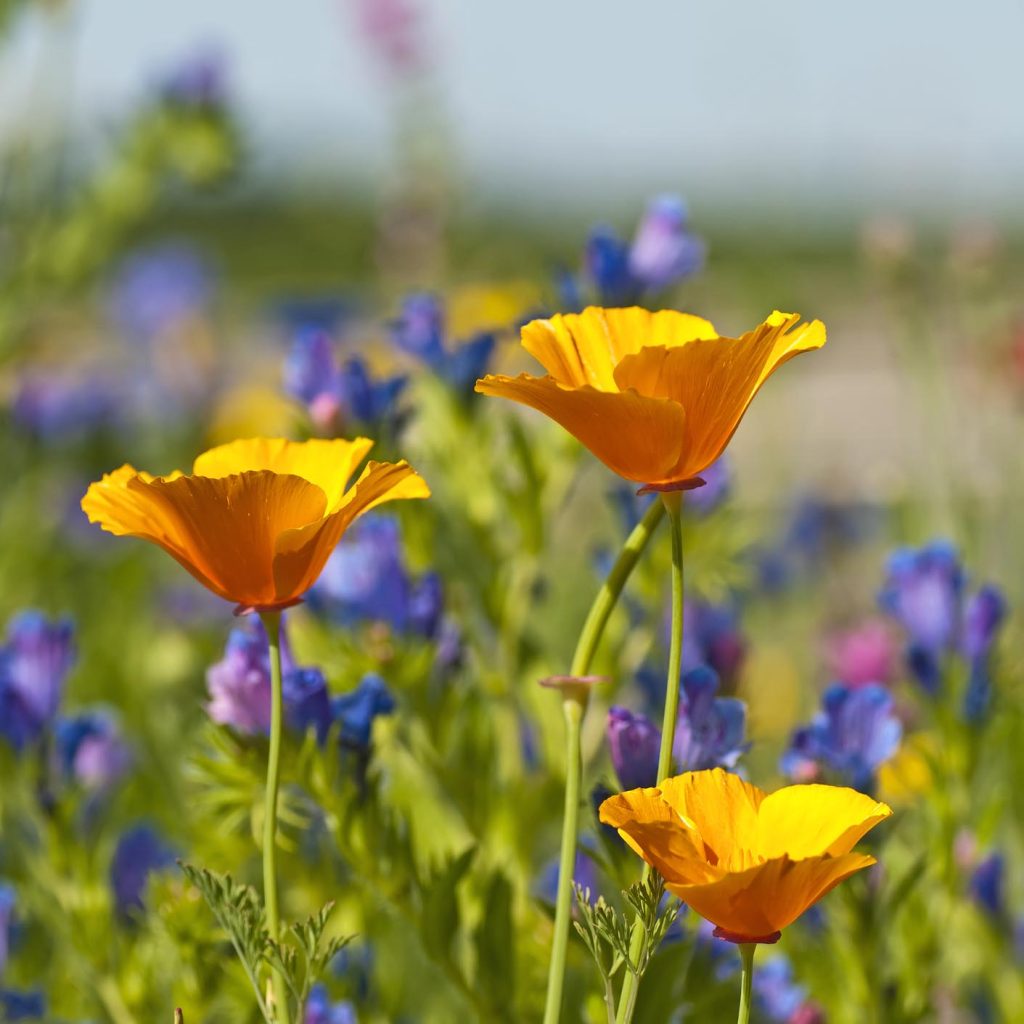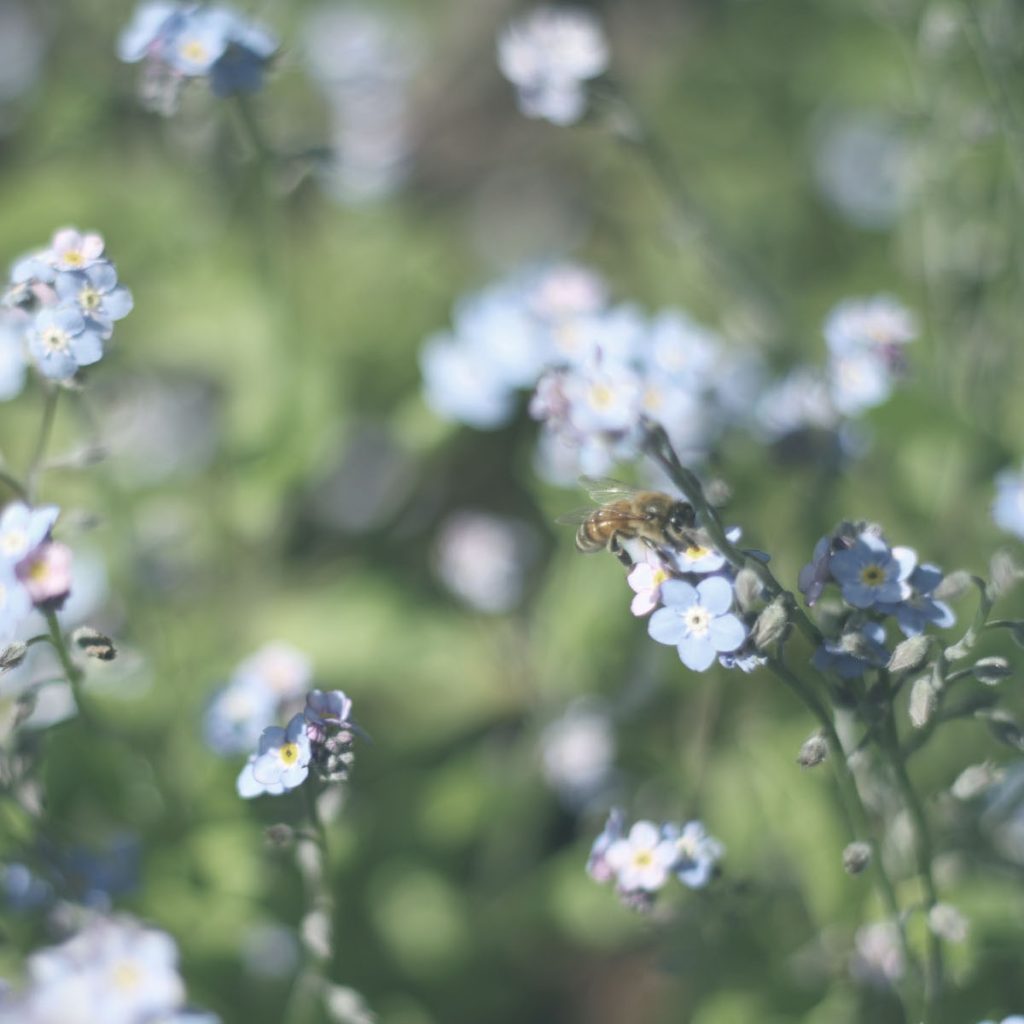BORN TO BE WILD – FLOWERS THAT IS

BORN TO BE WILD … FLOWERS THAT IS
It has begun. While preceding months have occasionally teased with gentler days, leaving dashed hopes as Nature capriciously reverted to her Winter ways, Spring is actually here! Warming temperatures, nurturing showers and a landscape of effervescent color now give evidence that the season of dormancy is clearly in hindsight.
New growth is everywhere, as deciduous trees, hydrangeas, wisteria, roses and a cast of garden companions too numerous to count unabashedly display their signature hues and fragrance. Beyond the confines of cultivars, and garden spaces groomed to our liking, however, there exists the oft-overlooked beauty of the native wildflowers. These ‘free spirits’ of the floral kingdom carpet hillsides, grace the under-canopy of forests and survive the most unlikely of habitats amidst urban sprawl. It’s time to take a closer look!
During our years as a nursery owners with a passion for landscape design, we often relied on the admittedly bold and visually stunning ornamentals typical to the average garden. We did, however, utilize ‘native plants’ to accommodate areas prone to drought, and other conditions less favorable to non-natives. Natives additionally lent a more subtle beauty in contrast to the more ostentatious newcomers.
With the diminishment of the natural habitat, and ‘wild’ places becoming more rare by the year, We have a renewed appreciation for those species that greatly predominated the meadows and general outdoors in our earlier lives. Indigenous wildflowers, blooming trees and shrubs are finally receiving their long overdue recognition within the gardening community, and we’ve personally adapted recent projects to accommodate the use of native plants, while using non-natives in a more peripheral role.
Historically, native plants and flowers were used as medicine, food, basket materials, ropes, and clothing, to name a few. Early European explorers to the Pacific Northwest and southern California were astounded at the depth and diversity of botanical life in the new world. These early visitors returned home with seedlings and starts, to commence propagation of their new-found wealth from our region.
Interestingly, for many years these same plants were rarely considered for use in home gardens, or landscaping in the Pacific northwest, particularly in California. It wasn’t until the early 1900’s that horticulturists, botanists, and plants women began paying attention to these ubiquitous beauties. This acknowledgment initiated efforts to protect, cultivate and educate, and thus avoid the possibility of losing these irreplaceable gifts forever. Notable botanical gardens were established in California during this same period for the express purpose of preservation and education, and by the mid 1960’s the California Native Plant Society was formed in support of this same goal.
Fortunately, those of us inhabiting northern California and southern Oregon still enjoy a significant expanse of wilderness relatively unmarred by the human footprint. Most notably, certain botanical specimens are endemic to our particular region of paradise exclusively, while Mid-March to early April marks the blossoming period for these unique natives.
Flowers always make people feel better, happier, and more helpful;
They are sunshine, food, and medicine for the soul
Within this context, we began our own exploration into botanical systems from the coastal town of Smith River, inland to the Jedediah Smith park, the Smith River canyons, and east, deep into the canyon to Big Flat. Here are some of our favorites from the many treasures we discovered, and in bloom right now:
Skunk cabbage – Latin( Lysichiton americanus) – Tolowa (Daa-chuu-se’s): Found in coastal bog/fen/wetland locations this striking bright green leaved/yellowish-green flowered native plant is the largest ‘wildflower’ of our region.Considered to be foul-smelling, it none the less is beautiful to behold. Utilized by the Tolowa Indians, its leaves were a food preservative, a vessel for drinking water, and a container to bake sturgeon eggs. The steamed root was used medicinally as a treatment for arthritis, stroke, tuberculosis and back pain.
Coast Strawberry – Latin (Fragaria chiloensis) Blooming April to June right after spring thaw this hardy groundcover is easy to identify. Looking essentially the same as its garden variety cousin, but smaller, this hardy perennial creeper can be brought into a traditional landscape provided it is planted in rich, well drained soil. Its tiny berries are quite tasty. Medicinal uses have been varied.Strawberry-leaf tea is acknowledged to possess diuretic and astringent properties, while high in vitamin C. In addition, fresh leaves have been chewed to treat mouth sores.
Oregon Grape – Latin ( Berberis aquafolium) – Tolowa (Dan’-dee-ch’ee-ye) The Oregon Grape grows from the Pacific coast to the eastern slopes of the Rockies. Resembling the holly it is often mistakenly identified until Spring when it bursts forth in glorious bright yellow blossoms followed by juicy reddish purple berries. Its edible berries are quite sour but can be eaten raw or cooked.The cleaned, dried, and chopped root was used by the Tolowa tribe as a blood purifier, as a treatment for pancreatitis, and for liver and kidney problems.Additionally, the root was used as a dye for basket making materials.
Tough-leafed Iris – Latin (Iris tenax) The hardiest of all in the native Iris family, this sturdy, mounding iris was everywhere we explored. Traditionally its tough leaf fiber was used to make nets, snares and ropes. As a landscape plant, once established it can handle drought and then reseeds. Considered the easiest iris to grow, it enhances any garden as a perennial border and/or edge of a garden pathway.
Trillium – Coast Trillium – Latin (Trillium ovatum) Rare and endangered in many places, this is one of the most unique and endearing of Springs early bloomers. The first time we came in contact with the coast trillium it was growing in dappled light in one of the last stands of old growth Doug Fir forest in Humboldt County on the Lost Coast. The slightly sweet fragrance combined with a delicate 3 petal flower that changes color from white to pink to mauve as it matures makes it one of nature’s most incredible creations.
Growing requirements are moist, hummus-rich, well drained soil with protection from the hot sun.They are long-lived garden perennials and can take up to 5-7 years to produce its first blossom. If picked while blooming they may die, so leaving them undisturbed is recommended. If you’re driving the Hwy 199 corridor from Hwy 101 towards Hiouchi, take a moment to stop and appreciate the abundance of trilliums in co-habitation within lush stands of fern and old-growth redwoods. They make outstanding companion plants, with the trillium flower illuminating the deep greens and browns of the forest.
Giant Purple Wakerobin – Latin (Trillium kurabayashii) The last and most remarkable native plant revealed itself to us on our own land. It initially escaped our notice, as it blended so well with the other forest colors.Its green leaves, with brown mottled spots and purple-brown flower keeps this treasure hidden from all but the educated eye. With the realization that we discovered a very large trillium variety, considered a rarity in the Trillium genus, we knew our garden was home to something remarkable.
It occurred to us that this lone trillium in our yard would most probably indicate its presence in the surrounding, undisturbed wooded areas. As anticipated, not far from our house in deep, rich, moist forest surrounded by ferns, we found an incredibly large grouping of these same trilliums. A thrilling find indeed!
We recently cleared a sunny slope in preparation for two large packages of a perennial native wildflower seed mix, including California poppies, lupine, yarrow, and bluebells to create a native wildflower habitat on our own property. Wildflower seeds are easy to plant, needing only a mere 1/8 to ¼ of an inch of soil to top dress, with no need for fertilizer; Nature rewarded our efforts, with wonderful spring showers the very next day!
We now joyously anticipate the first signs of our very own field of wildflowers, and whatever other hidden spring delights that await our notice. There’s still time for you to do the same!
As longtime nursery owners, certified Permaculturists & Master Gardeners and overseers of Alfa Vedic Botanical Gardens, Deborah & Barre Lando conduct community gardening classes from basics to master level, and share their substantial knowledge in organic gardening practices and garden Feng Shui.








